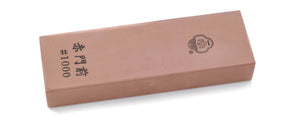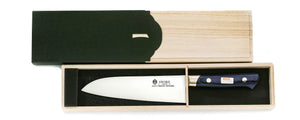How to Choose a Japanese Kitchen Knife for Beginners

Find Your Japanese Knife by Purpose
A Japanese Kitchen knife can last a lifetime with the appropriate care. At Sakai Ichimonji, we offer knives for every use and individual, no matter where they are in their culinary journey.
The first step is to find the knife that suits your purpose. The most common knives are the Gyuto and Santoku. They are great for nearly every task in the kitchen. The graphic below can help you choose which type is best for you.

Santoku Knives

A Santoku knife is a great primary kitchen knife. It usually has a blade that's 160-180 mm long, broad, and tapers down at the tip. The design lends itself to slicing meat, dicing vegetables, and a little bit of intricate cutting using the tip. Santoku are available with western-style handles or with Japanese-style handles (Wa-Santoku).
Recommended for:
Home cooks looking for a medium-sized all-purpose knife.
SWORD-FV10 Stainless Santoku Knife
• Made from VG10 with high levels of sharpness and toughness.
• Easy to sharpen.
• Long edge retention.
Gyuto Knives

The gyuto is the Japanese version of the classic chef knife. They are quintessential kitchen knives that come in multiple lengths, handle designs, and steel types. The gyuto can be used on nearly any meat or vegetable.
Recommended for:
• 180 to 210 mm models for home cooks seeking all-around performance.
• 210 to 300 mm models for chefs requiring extra length for slicing large produce.
Tokko Gyuto Chef's Knife
• Lasting sharpness comparable to stainless steel at 2–3 times the price range.
• Easy to sharpen.
• Although it is not stainless steel, light cleaning and wiping are enough to prevent rust.
Deba Knives

A Deba knife is a traditional Japanese knife used for filleting fish. The blade is thick and heavy, with a tip slightly pointing upwards. Its role is to cut through fish and chicken bones and slice through the soft flesh with a sharp point. Using the blade's heel, the knife can crack through crabs or other seafood shells. Most often, Deba are single-edged blades.
Recommended for:
Chefs involved in preparing seafood.
G-Line VG-1 Deba Knife
• Hygienic and easy-to-use Western-style handle.
• High durability and good sharpness.
Yanagiba Knives

Yanagiba are called sashimi knives or sushi knives because they are used in Japan to slice through large slabs of salmon, tuna and other fish. They are long, thin and sharpened on only one side, usually the right-hand side. Their design developed from the need to cut through fish without damaging the delicate fibers, ruining flavor and texture. They usually come in lengths of 180-360 mm.
Recommended for:
Chefs that make sushi or sashimi.
White Steel #1 Montanren Yanagiba Knife
• White Steel #1 is said to be an ideal material for knife blades due to its hardness and sharpness, in addition to its long edge retention and ease of sharpening.
• Our Montanren series is the epitome of this material, forged by highly skilled craftsmen at every step, from forging and tempering to the creation of the cutting edge, to achieve the best sharpness and edge retention.
Petty Knives

Petty knives are ideal for slicing small fruits and vegetables, as well as peeling and decorative food work. Typically available in lengths of 120 to 165 mm, they are essential for any kitchen.
Recommended for:
Home cooks and chefs.
SWORD-FV10 Stainless Petty Knife
• Thin handle makes it easy to peel food without using your thumb.
• Good sharpness because it is full VG10 steel.
• Sharpen it to the shape you want.
How to Choose a Japanese Knife

Stainless vs. Carbon Steel
The most important choice when buying your first Japanese Knife is between carbon and stainless steel.
Carbon steel knives offer the best cutting performance and ease of re-sharpening. However, they require more maintenance. Prolonged exposure to water or acids from foods will damage the blade and cause corrosion. Therefore, you must carefully wash and dry carbon steel knives each time.
A carbon steel knife is for you if you are prepared to do the work and want the ultimate cutting performance.
Stainless steel knives offer good cutting performance with far less need for such maintenance. A stainless steel knife is recommended if convenience and time-saving are your priorities.

Blade Length
The blade size you need will depend on your use case. As a general guide, we suggest the following.
• Santoku: 165 to 180 mm, ideal for home cooks.
• Gyuto: 210 mm for home cooks and 240 mm for chefs.
• Deba: 165 mm for home cooks and 210 mm for chefs.
• Yanagiba: 210 to 240 mm for home cooks and 270 to 330 mm for chefs.
• Petty: 120 mm for convenient peeling of small fruits and vegetables; 150 mm for larger cut ratios.

Handle Preference
Choosing a Japanese-style or Western-style knife handle depends on how you work with your knife. Many people new to Japanese knives may be more familiar with a Western-style handle. Japanese-style handles allow for different grip styles and sometimes more agile handling. This will require a little practice to get used to for most.
Most of our knives are made from natural wood (Japanese-style) or compressed wood (Western-style).
About Sakai Ichimonji

Our Story
Nearly 70 years ago, Hisaka Tanaka founded our knife shop in Osaka. He was inspired by the philosophy of dedicating one's life to mastering a craft, as demonstrated by the renowned swordsmith Ichimonji Narimune. This small brand has continued to meet chefs' needs in Japan and beyond.
Our shop is one of the few places where you can find 2,000 types of top-quality Sakai knives. Our blades have grown to be loved by even the most discerning chefs. While most of our customer base are masters of traditional Japanese cuisine, our knives' quality has been sought after by leading culinary professionals worldwide.
If they're used and taken care of properly, our knives can be used for decades and passed down from parents to children, from masters to students.

Why Choose Sakai Ichimonji Mitsuhide?
1. Exceptional Sharpness
Our knives are sharper and longer-lasting because our artisans use traditional techniques to draw out the potential of the raw materials.
2. Beautiful Designs
Perhaps you want a blade with a mirror finish to enhance your kitchen's splendor and make cutting easier. Maybe you prefer the stylish patterns of Damascus, which add strength to the blade. Whatever your needs are, you'll find them in our wide range of visually pleasing and practical knives.
3. Knives for Any Need
Our Osaka store carries over 2,000 different Sakai knives. However, our online store only offers a limited selection. If you are having trouble finding the right knife on our site, please don't hesitate to contact us, and we'll provide suggestions. We also welcome requests for custom-made knives.

Sakai Ichimonji Representative, Ryo Tanaka
Since my grandfather, Hisaka Tanaka, was engaged in knife making in Sakai and founded the company to bring knives to more people, I have the same desire.
Japanese kitchen knives are tools that can accompany you through your life or even into the next generation. It's not unusual to receive a 40-year-old kitchen knife with a sharpening service ticket, saying, "This is the knife my grandfather used."
We are proud to have supported many users over the years and created Japanese food culture in Doguyasuji. This iconic shopping street is where professional chefs come to set up their restaurants. We're thrilled you'll be able to pick up one of our kitchen knives and draw a new page in culinary culture in your country.




































